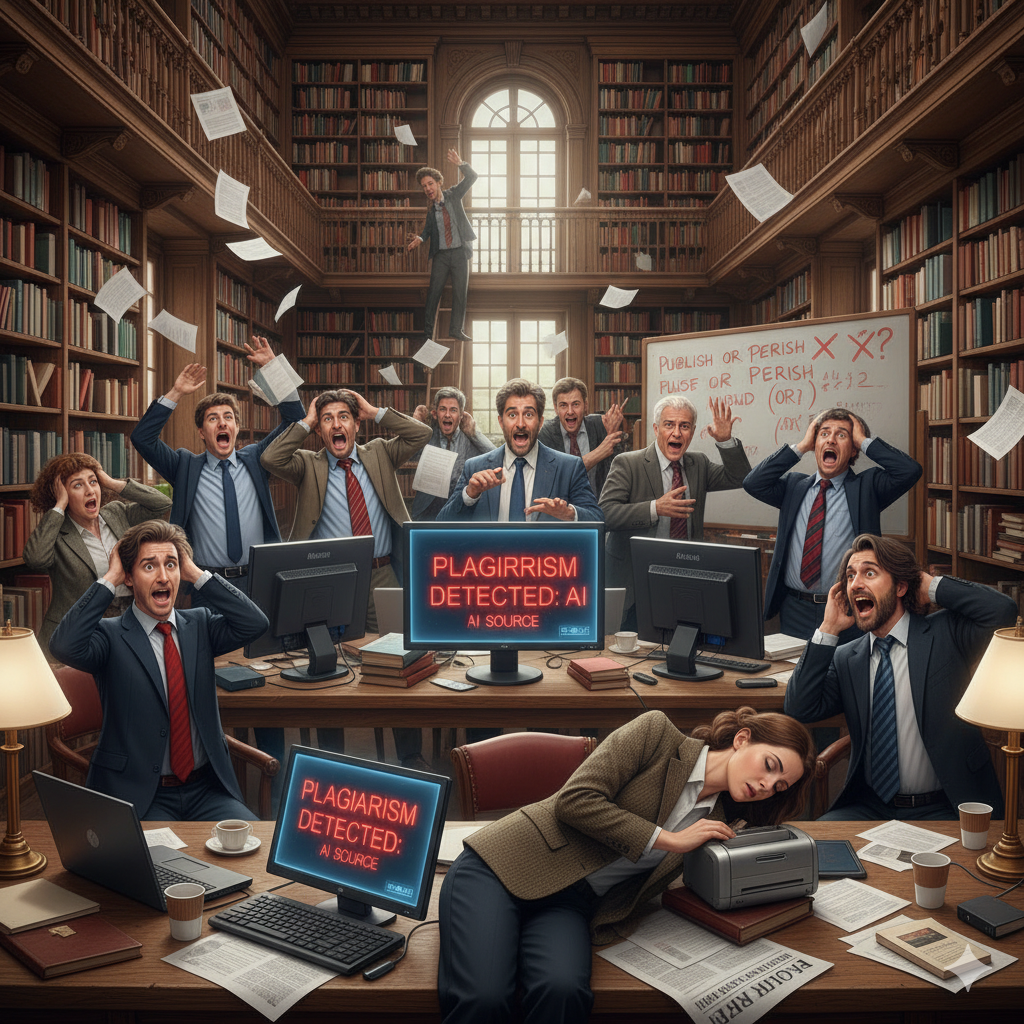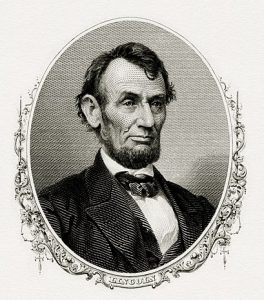AI Discovers Thousands of Plagiarized PhD Dissertations: “Academics in Panic”
By Dan Geddes
SAN FRANCISCO – A new AI application has discovered that thousands of PhD holders from US universities plagiarized some or all of their dissertations’ research.
“We are now in the greatest crisis of confidence in American academic history,” according to Professor Eugene Borgia of Rockefeller University. “Academics are in panic. If it is known that these professors are totally dishonest scam artists, this may affect their future employment prospects.”
The AI software, called TruthBot, has determined that many PhD dissertations and academic papers generated by AI applications or via human plagiarism and yet were still approved by mentors and dissertation committees and published by university presses.
Truthbot’s developers, probably fearing litigation, did not release their findings directly to the public, but instead contacted more than 2,000 American universities which awarded PhD degrees based on allegedly plagiarized research.
TruthBot explained that they created their software to defend academic integrity.
“TruthBot was certainly not targeted specifically toward my legions of academic enemies or former lovers,” said AI lead developer, Dr. Timothy Leery. “I have just always been intellectually honest and so I demand the same academic rigor from my peers that I do from myself. I admit it is a pity that my former mentor and lover, Dr Sandy Brothers, has now been totally discredited due to her wanton plagiarism from my work and others over the years. It is a damn shame her sham career and her sham marriage are now both destroyed due to my beautiful TruthBot, the new passion of my life,” lamented Dr. Leery.
Academic Response
Different universities have had different reactions to the TruthBot revelations. Universities are uncertain whether to file academic integrity proceedings against all the offending professors.
It would literally decimate our professoriate,” said Dr. Curt Le May, of the Peace Studies department at the US Naval Academy at Annapolis.
Professor William T. Sherman, a Latin instructor at Annapolis added: “More than decimate. Decimate means to cut by 10%: from the Latin, decem. We could see 30% of professors in some fields facing disciplinary proceedings. Thus, it is more likely to trīgintāte us than to decimate us,” explained Dr. Sherman pedantically. “Many people may not realize this. That is what us academics are for.”
Dr. Ignatius Xavier of Georgetown University, whose dissertation “Aristotle’s Epistemology Applied to AI” was itself found by TruthBot to be largely AI-generated, defended himself: “Who are we to judge? Plagiarism was standard practice in the Middle Ages, just five hundred years ago. Many philosophers just plain stole from Aristotle verbatim without attribution and it was no problem. If they thought it was good, they threw some Aristotle in there. It was fine. Standards about plagiarism are culturally relative over time and space, just like other values. We should not be so judgmental about something so culturally relative. Maybe we need to give everyone a bye on this one. A mulligan. Just this one time.”
“It’s actually a good time for a downsizing in academia anyway,” opined Dr. Eugene Borgia of Rockefeller University. “Demographics practically demand it anyway. Fewer young people are attending university. Many PhDs cannot get a job in their fields already. Depopulation seems to be working—or happening somehow,” according to Dr. Borgia.
Republishing PAP
Some academics are thinking of creative schemes to rehabilitate these plagiarized works, now known as PAP (plagiarism assisted papers).
Universities have already initiated “plagiarism assisted paper amnesty” (PAPA) programs, which allow doctorate holders to come forward and admit that their dissertations or other academic works contain plagiarized elements. Those researchers who confess to publishing PAP are permitted to revise and resubmit their dissertations with the plagiarized passages removed or properly cited.
Some academic publishers immediately supported the PAPA program. Industry spokeswoman J.P. Morgan stated: “While we were deeply saddened to learn that we had unwittingly published PAP; the PAP Amnesty program helps rectify the situation. Academia needs PAPA now, more than ever.”
Other academics criticized the PAPA program. Professor Harold Hill of the academic integrity organization SCHMEAR (SCHolars for Minimization of Errors in Academic Research) called the program “ludicrous. Of course, the publishers like the idea: if they republish all this PAP this means republishing of thousands of works, which will generate windfall profits for the publishers. SCHMEAR takes a firm stand against republishing PAP.”
“We at SCHMEAR are beyond sad that more than 500 PhDs were ‘written’ by a single AI, known as PaperMill.AI, which is still operational to this day. This is trouble with a capital ‘T’, claimed Professor Harold Hill. “There ought to be a law against it.”
Others opposed PAP amnesty and proposed that all plagiarized papers would have to be fully expunged from the research databases.
Citation Contamination
Even this extreme measure may not fully resolve the problem. “If the plagiarized papers are summarily expunged, then we would still have a problem: the poor saps who cited the PAP would look like crap—like they had invented research out of thin air,” according to Professor Claude Roget, formerly of NYU.
“Expunging all these articles, whether for minor plagiarism or for being partly or fully AI generated will put an enormous hole in our academic records and our research. If thousands of articles with high impact factor are expunged, unpublished, or discredited, think of the thousands of other articles that cite those expunged articles. Those authors will look stupid for having cited plagiarized or AI-faked academic research without having noticed the deception themselves.”
“I personally coined the term ‘citation contamination’ decades ago to describe this phenomenon of a chain of plagiarism and attribution thereto that infects all works which come into contact with it,” claimed Roget. Other academics quickly contested Roget’s claim to have coined the term “citation contamination,” claiming they had originated the term.
TruthBot’s Detractors
Many academics protested their innocence and wanted to appeal the findings of the AI’s LLM model. “I feel like I am the victim of some PAP smear tactics,” said Dr. Xavier of Georgetown. “The results of the TruthBot model are often probabilities rather than certainties. They use vectors, which are mere mathematical representations of a query. Computers make mistakes. AI models hallucinate.”
“We categorically deny that our models hallucinate,” stated Dr. Timothy Leery of TruthBot. “Our models have been trained on the best curated academic research data that we could scrape off the web.”
Attorney Bram Stokely, who is defending some of the discredited professors, opined: “We need to determine if the dataset used by TruthBot to train its AI model was not itself founded on contaminated data. Shouldn’t we investigate whether the TruthBot engine itself is plagiarized from other software or whether it used plagiarized documents in its training model? Even if they contain identical passages, how do we even know which paper stole from which?”
Dr. Leery responded dismissively: “Unless we are talking about time machines, the publish date usually determines whose work was earlier,” claimed Leery. “I’m pretty sure Aristotle’s works predate Dr. Xavier’s.”
According to data supplied by SCHMEAR, an unusual number of submissions to academic journals have recently been suddenly withdrawn, perhaps to avoid being detected as AI-generated PAP.
“Clearly, peer review needs an overhaul. But it is still more valuable than ever,” concluded Dr. Borgia.






Be First to Comment